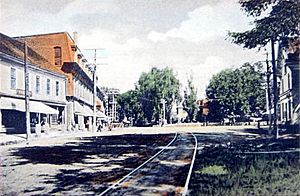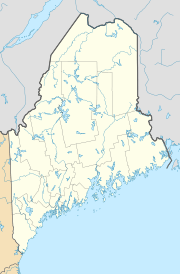South Berwick, Maine facts for kids
Quick facts for kids
South Berwick
|
|
|---|---|

Central Square c. 1910
|
|
| Nickname(s):
The Berwicks
|
|
| Country | United States |
| State | Maine |
| County | York |
| Settled | 1631 |
| Incorporated | 1814 |
| Villages | South Berwick Emerys Bridge Great Works Jewett |
| Government | |
| • Type | Town Council |
| Area | |
| • Total | 32.64 sq mi (84.54 km2) |
| • Land | 32.13 sq mi (83.22 km2) |
| • Water | 0.51 sq mi (1.32 km2) |
| Elevation | 43 ft (31 m) |
| Population
(2020)
|
|
| • Total | 7,467 |
| • Density | 232/sq mi (89.7/km2) |
| Time zone | UTC-5 (Eastern) |
| • Summer (DST) | UTC-4 (Eastern) |
| ZIP code |
03908
|
| Area code(s) | 207 |
| FIPS code | 23-70030 |
| GNIS feature ID | 0582732 |
South Berwick is a town in York County, Maine, United States. In 2020, about 7,467 people lived there. South Berwick is special because it's home to Berwick Academy. This is a private school that helps students get ready for college. It was started way back in 1791!
The town was once part of a larger area called Berwick. It became its own town in 1814. Later, North Berwick also became a separate town in 1831. South Berwick is part of the larger Portland area.
Contents
History of South Berwick
Early Days and Native Americans
The area where South Berwick is today was first called Newichawannock by the Abenaki Indians. This name means "river with many falls." It refers to the Salmon Falls River.
Around 1631, Europeans started to settle here. It was part of Kittery back then. A man named Ambrose Gibbons built a trading post called the Great House. It was a strong, fenced-in building where people traded goods with the Native Americans.
First Mills and Scottish Workers
In 1634, some people from England came to build a sawmill and a gristmill. These mills used water power to cut wood and grind grain. The first houses in South Berwick were built around this time.
Later, in 1651, a bigger sawmill was built. It was so big it was called the "Great mill workes." This is where the Great Works River gets its name. About 25 Scottish prisoners of war worked at this mill. They were captured in a battle and sent to America. They worked as indentured servants, meaning they worked for a set time to earn their freedom. Because of the ship they arrived on, the community was even called the Parish of Unity for a while.
Wars and Becoming a Town
The village faced attacks in 1675 during King Philip's War. It was attacked again in 1690–1691 during King William's War by Native Americans and French soldiers. The Parish of Unity was burned down and left empty for a time.
But people came back! In 1703, it was settled again and called Newichawannock. In 1713, it officially became a town named Berwick. It was named after a town in England near the Scottish border.
Berwick Academy, a famous school, opened in 1791. Then, on February 12, 1814, South Berwick officially became its own separate town.
Mills and Famous Writers
In the 1800s, many mills were built along the rivers. They used the power of the water to run machines. One big cotton mill, the Portsmouth Manufacturing Company, opened in 1831. It made millions of yards of cloth each year! This mill closed in 1893. Today, its old office building is a museum run by the Old Berwick Historical Society.
South Berwick also made woolen clothes, shoes, plows, and lumber. The town was also known for its apple orchards. The center of the village is now a historic district.
A famous author named Sarah Orne Jewett lived in South Berwick. She wrote a book called The Tory Lover in 1901. It was set at the Hamilton House, a beautiful old mansion built around 1785. Both the Hamilton House and Sarah Orne Jewett's own house are now museums.
-
Fogg Memorial at Berwick Academy
-
Sarah Orne Jewett House c. 1910
Geography and Rivers
South Berwick covers about 32.64 square miles (84.54 square kilometers). Most of this area is land, with a small part being water. The town is right next to the New Hampshire border.
Two important rivers flow through South Berwick: the Great Works River and the Salmon Falls River. The highest point in town is Welch Hill, which is about 370 feet (112.8 meters) above sea level. The lowest point is along the Salmon Falls River, at sea level.
Population Changes
South Berwick has grown quite a bit over the years. Here's how its population has changed:
| Historical population | |||
|---|---|---|---|
| Census | Pop. | %± | |
| 1820 | 1,475 | — | |
| 1830 | 1,577 | 6.9% | |
| 1840 | 2,314 | 46.7% | |
| 1850 | 2,592 | 12.0% | |
| 1860 | 2,624 | 1.2% | |
| 1870 | 2,510 | −4.3% | |
| 1880 | 2,677 | 6.7% | |
| 1890 | 3,434 | 28.3% | |
| 1900 | 3,188 | −7.2% | |
| 1910 | 2,935 | −7.9% | |
| 1920 | 2,955 | 0.7% | |
| 1930 | 2,650 | −10.3% | |
| 1940 | 2,546 | −3.9% | |
| 1950 | 2,646 | 3.9% | |
| 1960 | 3,112 | 17.6% | |
| 1970 | 3,488 | 12.1% | |
| 1980 | 4,046 | 16.0% | |
| 1990 | 5,877 | 45.3% | |
| 2000 | 6,671 | 13.5% | |
| 2010 | 7,220 | 8.2% | |
| 2020 | 7,467 | 3.4% | |
| U.S. Decennial Census | |||
In 2010, there were 7,220 people living in South Berwick. Most people were White (97.5%). About 26.6% of the people were under 18 years old. The average age in the town was about 40.5 years.
Strawberry Festival
Since 1976, South Berwick has held a fun Strawberry Festival every year. It happens on the last Saturday in June. The festival started to celebrate the 200th birthday of the United States. It was so popular that they decided to keep doing it!
At the festival, you can find shops, food, and games. There are also rides for children and trolley rides. The festival takes place at Central School, which is the main elementary school in South Berwick.
Places to Visit
South Berwick has several interesting places to explore:
- Counting House Museum – Learn about the town's history.
- Hamilton House – A beautiful old mansion.
- Jewett-Eastman House – Another historic home.
- Sarah Orne Jewett House – The home of the famous author.
- Vaughan Woods State Park – A great place to enjoy nature.
- Punkintown – A unique local spot.
Famous People from South Berwick
Many notable people have connections to South Berwick, including:
- Nicholson Baker (born 1957), a writer of novels and non-fiction.
- John H. Burleigh (1822–1877), a U.S. congressman.
- Sarah Orne Jewett (1849–1909), a well-known novelist.
- Robert M. Pirsig (1928–2017), a writer and philosopher.
- Deanna Rix (born 1987), a talented wrestler.
Sister City
South Berwick has a sister city:
See also
 In Spanish: South Berwick para niños
In Spanish: South Berwick para niños






